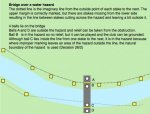mikejohnchapman
Challenge Tour Pro
Had a problem recently in a match when my opponents ball came to rest on a bridge made of sleepers over a hazard.
The ball was at the end of the bridge but still on the wood. The sleepers were set into the bank of the ditch and my opponent maintained the ball wasn't in the hazard.
We agreed the hazard extended vertically but he said that the sleepers extended beyond the hazard.
The problem was the hazard was not lined and as the ditch curved the yellow posts didn't give a definitive line.
I maintained the hazard followed the natural line of the ditch which meant his ball was in the hazard, but he disagreed.
How do you determin the line of the hazard when it isn't lined.
The ball was at the end of the bridge but still on the wood. The sleepers were set into the bank of the ditch and my opponent maintained the ball wasn't in the hazard.
We agreed the hazard extended vertically but he said that the sleepers extended beyond the hazard.
The problem was the hazard was not lined and as the ditch curved the yellow posts didn't give a definitive line.
I maintained the hazard followed the natural line of the ditch which meant his ball was in the hazard, but he disagreed.
How do you determin the line of the hazard when it isn't lined.

